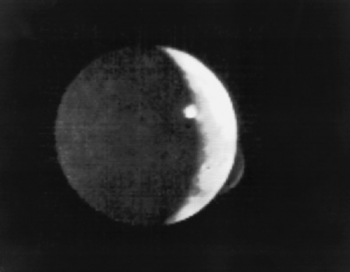The discovery of volcanoes on Io

On March 8, 1979, as Voyager 1 was speeding away from Jupiter after its historic flyby of the gas giant three days earlier, it looked back at the planet and took some navigational images. Linda Morabito, one of the engineers in charge of using these navigational images to make sure the spacecraft was on its planned course, took one look at the image on the right, an overexposed image of the moon Io, and decided that it had captured something very unusual. On the limb of the moon was this strange shape that at first glance looked like another moon partly hidden behind Io. She and her fellow engineers immediately realized that this was not possible, and that the object was probably a plume coming up from the surface of Io. To their glee, they had taken the first image of an eruption of active volcano on another world!
Today, on the astro-ph preprint website, Morabito has published a minute-by-minute account of that discovery. It makes for fascinating reading, partly because the discovery was so exciting and unique, partly because it illustrated starkly the human nature of science research, and partly because of the amazing circumstances of that discovery. Only one week before, scientists has predicted active volcanism on Io in a paper published in the journal Science. To quote her abstract:
In the 2 March 1979 issue of Science 203 S. J. Peale, P. Cassen and R. T. Reynolds published their paper “Melting of Io by tidal dissipation” indicating “the dissipation of tidal energy in Jupiter’s moon Io is likely to have melted a major fraction of the mass.” The conclusion of their paper was that “consequences of a largely molten interior may be evident in pictures of Io’s surface returned by Voyager 1.”
Only one week later Morabito had confirmed this hypothesis. In fact, the image above had captured two eruptions, because further research found that the bright spot on the terminator was that of another volcano erupting.
Because Morabito was not part of the science team, she had to fight to make sure she and her fellow navigational engineers got credit for the discovery. Moreover, the discovery itself might have gone unnoticed if she had not stuck with it, pushing the issue when others, exhausted from the past week of intense work and sleepless nights because of the Jupiter fly-by, wanted to put it aside as something that could be dealt with later.
The story is interesting too because it illustrates how planetary science has evolved since these early days. I doubt that today any engineering image produced by a spacecraft is considered less important, as it was with this first Voyager 1 fly-by. When Curiosity takes an engineering image today, everyone looks at, including the science team. The same thing I am sure takes place with Cassini in orbiter around Saturn, and with Venus Express in orbit around Venus, and with all other planetary probes. The data that comes down is too precious. Everything has to be perused, carefully.
And if the science team doesn’t look carefully, I guarantee that someone on the engineering team will, which will cause some unhappy faces on the science team if an important discovery — like Morabito’s — is then made!
On Christmas Eve 1968 three Americans became the first humans to visit another world. What they did to celebrate was unexpected and profound, and will be remembered throughout all human history. Genesis: the Story of Apollo 8, Robert Zimmerman's classic history of humanity's first journey to another world, tells that story, and it is now available as both an ebook and an audiobook, both with a foreword by Valerie Anders and a new introduction by Robert Zimmerman.
The print edition can be purchased at Amazon or from any other book seller. If you want an autographed copy the price is $60 for the hardback and $45 for the paperback, plus $8 shipping for each. Go here for purchasing details. The ebook is available everywhere for $5.99 (before discount) at amazon, or direct from my ebook publisher, ebookit. If you buy it from ebookit you don't support the big tech companies and the author gets a bigger cut much sooner.
The audiobook is also available at all these vendors, and is also free with a 30-day trial membership to Audible.
"Not simply about one mission, [Genesis] is also the history of America's quest for the moon... Zimmerman has done a masterful job of tying disparate events together into a solid account of one of America's greatest human triumphs."--San Antonio Express-News

